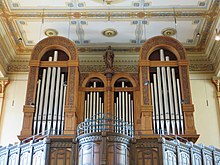Tuttlingen town church
The Protestant town church is a 19th century church in Tuttlingen in the Tuttlingen district in Baden-Württemberg .
With a classicist basic design, an Art Nouveau facade , a neo-Romanesque bell tower and a historicist gable based on the secular building of the German Renaissance , it unites architectural elements from the beginning of the 19th to the beginning of the 20th century to an exemplary eclectic overall picture.
history
The previous building, the Peter and Paul Church, had to be demolished after the city fire in 1803. A makeshift wooden church collapsed during a storm. Construction began on the current town church in 1815.
It was built to designs by the building inspector Carl Christian Nieffer (* 1787), a student of the Stuttgart court architect Nikolaus Friedrich von Thouret . The inauguration took place on the 300th anniversary of the posting of the theses of the Reformation - on October 31, 1817. The church was built in the classical style and was based on a Greek temple.
With the new wealth of citizens acquired during industrialization , the desire for a more magnificent and modern church grew. In 1868 the tower was increased to 68 meters. It should continue to surpass the tower of the planned Catholic St. Gallus Church. On the 100th anniversary of the city fire, the city church was redesigned in 1903. It received its current appearance in Art Nouveau. A mighty gable was erected on the north facade facing Bahnhofstrasse.
After deliberations up to profanation and demolition had been made in the 1960s , the city church was restored from 1974 to 1978. The Tuttlingen sculptor Roland Martin redesigned the altar, pulpit and baptismal device. The northern part of the church was spatially separated for the anteroom and side rooms, the hall was reduced in size, the organ relocated, the upper gallery removed, new chairs and floor heating installed.
architecture
The building is a hall church . Architecturally, Nieffer's classicist design is close to Karl Friedrich Schinkel's Neuer Wache in Berlin. The roof is a characteristic Tuttlingen hood .
With reference to the twelve gates of Jerusalem, three gates were placed on each of the four sides.
The tower was raised in neo-Romanesque style.
The church was redesigned in the Art Nouveau style. The north facade is adorned with a mighty gable. Four pilasters - connected by arches - and capitals , on which the evangelists Matthew (with a person) and John (with an eagle) as well as the two earlier church patrons Peter (with key) and Paul (with sword) stand, were put on. In the gable triangle there is a representation of Christ. Christ, Petrus and Matthäus are works by the Stuttgart sculptors Lindenberger and Rühle, Paulus and Johannes were created by the Tuttlingen sculptor Christian Teufel.
Furnishing
The statues of Christ, Peter, Matthew, John and Paul, which adorn the Art Nouveau facade, can also be found in the interior of the church. In 1893 Rudolf Yelin the Elder painted Ä. (1864–1940) the pictures on the pulpit wall of Jesus' prayer fight in Gethsemane and Ascension , as well as below the frieze-like pictures of Jesus as a friend of children and carrying the cross . The altar wall was structured by the Reutlingen artist Fritz Hummel using a painted-on Renaissance architecture. The Stuttgart architect Heinrich Dolmetsch renovated the interior and facade in the Art Nouveau style in 1903. Door and window frames as well as church pews received carved wood decorations, as did the parapets of the two galleries, the pulpit and the new organ case.
organ
The organ of the city church was built in 1978 by the organ building company Peter Mönch (Überlingen) in the historical case of the predecessor organ from 1903, and expanded in 2006 to include a tubular bell chime and electric setter combinations. The instrument has 46 registers and 2980 pipes. The key actions are mechanical, the stop actions are electrical.
|
|
|
|
||||||||||||||||||||||||||||||||||||||||||||||||||||||||||||||||||||||||||||||||||||||||||||||||||||||||||||||||||||||||||||||||||||||||||||||||||||||||||||||
- Coupling : II / I (16 '/ 8' / 4 '), III / I (16' / 8 '/ 4'), III / II (16 '/ 8' / 4 '), I / P (8' / 4 '), II / P (8' / 4 '), III / P (8' / 4 ')
- Secondary register: tubular bell chimes, g 0 –g 2 , playable on the III. Manual and in the pedal
- Playing aids : electronic typesetting system
Events
The town church shapes the cultural life of Tuttlingen, especially with organ and oratorio concerts by the choir.
"Symbol of Protestant self-confidence"
Surrounded by a predominantly Catholic surrounding area, it was important for the majority of the Protestant residents of Tuttlingen after the city fire in 1803 to set a symbol for Protestantism in southern Württemberg with an appropriate church building.
literature
- Karl Becker: The restoration of the Evangelical City Church in Tuttlingen. In: Preservation of monuments in Baden-Württemberg , 6th year 1977, issue 1, pp. 1–5. ( online as PDF; 8.6 MB)
Web links
Individual evidence
- ↑ Disposition of the organ on the website of Mönch Orgelbau , last accessed on October 4, 2017
Coordinates: 47 ° 59 ′ 1.8 ″ N , 8 ° 49 ′ 1.5 ″ E



